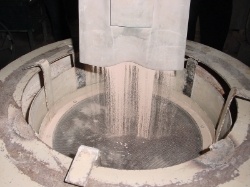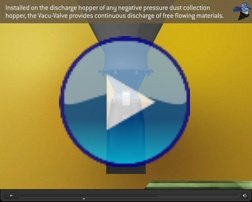Material handling valves come in all shapes, sizes, varieties, and there are hundreds of available options for each style. From rotary valves and knife gate valves to double dump valves and trickle valves the choices are nearly endless. With such a vast selection available, choosing the right material handling valve for a given application can be a difficult task and choosing the wrong valve can be costly. While there may be more than one possible solution to a material handling need, there is often a best solution to be found if the proper considerations are given. Here are the top 5 questions any plant manager or plant engineer should ask when choosing a material handling valve.
1) What is the Nature of the Material Being Handled?
What’s up with your dust? Probably the most important consideration for any material handling application is of course the material itself. The characteristics of the material being handled will determine what type of valve should be selected. Extremely fine material typically requires a valve with tight tolerances and seals to avoid material from dusting out to the atmosphere. Coarse or chunky materials often require a valve with larger clearances to avoid plugging or jamming of the valve mechanism. A common problem some rotary valves experience is large chunks of material becoming jammed between the rotor vanes and valve housing. While some design innovations exist to prevent this type of problem from occurring, sometimes the best solution is selecting a different type of valve more suited to the material being handled. Double-dump or double flap gate valves are designed to allow large, chunky and abrasive materials to pass through with minimal chance of blockage. Pairing the proper valve type to the material being handled is crucial for a successful installation.

2) Will The Valve Meet Your Operational Parameters?
Not all valves are created equally and the environments they are expected to operate in vary as well. In many cases material handling valves are put to use on systems with some degree of atmospheric pressure differential. Most material handling valves are intended to be airlocks as well; allowing solid material to pass through the system without allowing major pressure losses. Be sure to select a material handling valve that has a pressure rating within the range it will be expected to operate.
Temperature is another operational condition that should be taken into account. Any gaskets or synthetic seals should be rated to handle the expected process temperatures. High-temperature bearings or bearing stand-offs should be utilized in order to maintain functionality in extreme conditions. Abrasive or corrosive materials may require special material construction. So again, it is imperative that you really know and understand your dust!
In addition to atmospheric conditions, it is also important to consider the type of work demanded of the material handling valve. A rotary valve intended for use as a material feeder may have far different requirements than a rotary valve intended for use as a dust collector airlock. A knife gate valve intended to meter material flow will have a very different service life than a knife gate used strictly as a maintenance valve to shut off material flow during periodic system maintenance. Be sure to always consider the duty cycle and expectations placed on a valve.
3) How Should the Valve Be Powered?
All too often, plant maintenance personnel accept the “standard” valve control type listed by the manufacturer rather than choosing the best actuation method for the job. Pneumatic cylinders are the most widely used actuators for knife gate valves and many other process valves due to their continuous-duty rating and readily available shop air supplies. While pneumatic controls may appear to be an easy and convenient method to operate a knife gate valve, a manually operated unit may be more suitable and cost-effective for maintenance valves which are operated very infrequently. Many double dump valves use pneumatic cylinders to provide a precisely timed open-close sequence.
In some cases however, a specific timing sequence is not as crucial as consistent and reliable operation. A mechanically operated double dump valve using an electric motor-driven cam offers lower cost and fewer components to fail or replace. A trend in powering rotary valves is the use of electric gear motors which combine an electric motor and gear reduction box into one compact unit. While this method of operation has its advantages, it lacks the flexibility of a traditional chain drive assembly.
One type of valve gaining popularity for dust collection equipment is a non-powered automatic valve such as vacuum operated trickle valves. These valves utilize the negative pressure of a cyclone or baghouse to hold a rubber sleeve closed and create an airlock seal. As material builds up on top of the valve, the valve is forced open to automatically discharge collected dust. Trickle valves work best with dense free-flowing materials and are typically a fraction of the cost of most other dust discharge valves.

Click here to watch an animated demo of a trickle valve system
4) How Easy is it to Maintain?
Regular maintenance is a must for any material handling valve. As valve parts wear or material build-up occurs, the need for replacement, repair, and cleaning of the valve is inevitable. When choosing a material handling valve, one needs to pay close attention to how easy (or not easy) the valve is to maintain. Quick-release access panels, change-in-place parts, and easily accessed wear parts all make the job of performing regular service on a valve much easier.
Another aspect that will affect the maintenance of a valve is the valve’s overall reliability. Even a valve with easily accessed or easily replaced parts can still become a maintenance nightmare if those parts frequently break or wear out. Choosing a valve for reliability and ease of maintenance will help to save time and money over the life of the valve.
5) How Much Will it Cost?
While the initial investment for a material handling valve is important, it is only part of the equation. Frequent repairs or labor-intensive repairs to a valve can easily eat into any initial savings in cost. The cost of process downtime due to maintenance needs can become magnified if the valve cannot be repaired in place or replacement parts are not readily available. For dust collection systems it is often recommend to install a knife gate valve above the primary material discharge valve to be used as a service valve. The knife gate can be used to temporarily seal the system while maintenance is performed on the primary valve. Although the addition of a knife gate valve to the system adds to the overall cost, the benefit of avoiding a system shutdown during maintenance can far outweigh this cost.
Doing the proper due-diligence also goes a long way in selecting the best material handling valve for a given application. Just because a rotary airlock is the most familiar type of valve does not mean it is the right type of valve for the job. There may be a less expensive type of valve that can easily handle the same task or a more expensive valve that is more appropriate for the application. Realistically, the success of a material handling valve comes down to the careful consideration of application parameters and how much time and effort is given to make sure the appropriate valve is selected.

